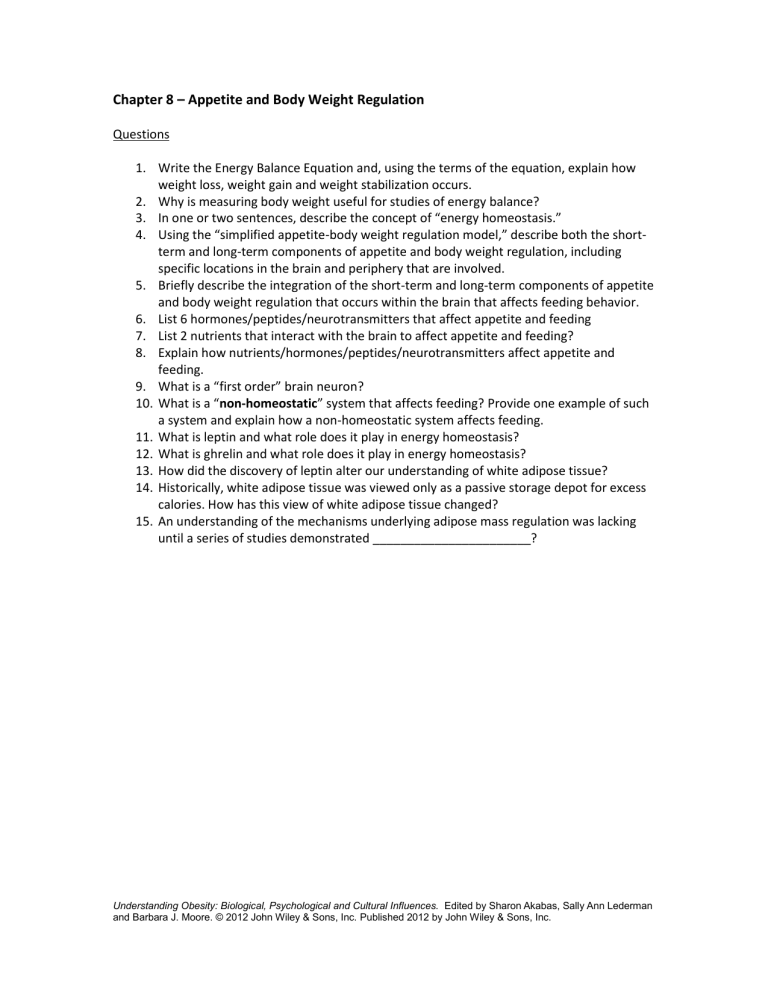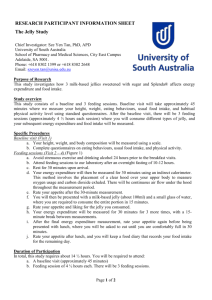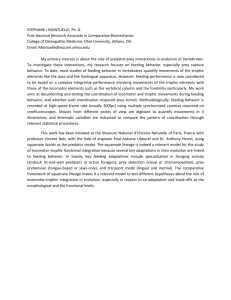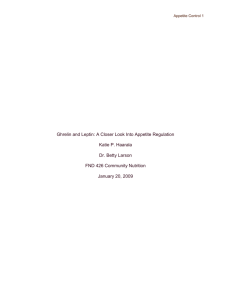Chapter 8 – Appetite and Body Weight Regulation Questions Write

Chapter 8 – Appetite and Body Weight Regulation
Questions
1.
Write the Energy Balance Equation and, using the terms of the equation, explain how weight loss, weight gain and weight stabilization occurs.
2.
Why is measuring body weight useful for studies of energy balance?
3.
In one or two sentences, describe the concept of “energy homeostasis.”
4.
Using the “simplified appetite-body weight regulation model,” describe both the shortterm and long-term components of appetite and body weight regulation, including specific locations in the brain and periphery that are involved.
5.
Briefly describe the integration of the short-term and long-term components of appetite and body weight regulation that occurs within the brain that affects feeding behavior.
6.
List 6 hormones/peptides/neurotransmitters that affect appetite and feeding
7.
List 2 nutrients that interact with the brain to affect appetite and feeding?
8.
Explain how nutrients/hormones/peptides/neurotransmitters affect appetite and feeding.
9.
What is a “first order” brain neuron?
10.
What is a “non-homeostatic” system that affects feeding? Provide one example of such a system and explain how a non-homeostatic system affects feeding.
11.
What is leptin and what role does it play in energy homeostasis?
12.
What is ghrelin and what role does it play in energy homeostasis?
13.
How did the discovery of leptin alter our understanding of white adipose tissue?
14.
Historically, white adipose tissue was viewed only as a passive storage depot for excess calories. How has this view of white adipose tissue changed?
15.
An understanding of the mechanisms underlying adipose mass regulation was lacking until a series of studies demonstrated _______________________?
Understanding Obesity: Biological, Psychological and Cultural Influences. Edited by Sharon Akabas, Sally Ann Lederman and Barbara J. Moore. © 2012 John Wiley & Sons, Inc. Published 2012 by John Wiley & Sons, Inc.
Chapter 8 – Appetite and Body Weight Regulation
Answers
1.
The Energy Balance Equation is defined as:
Change in energy stores = Energy intake – Energy expenditure
Weight loss occurs when energy intake is consistently less than energy expenditure.
Weight gain occurs when energy intake consistently is greater than energy expenditure; and weight stabilization occurs when energy intake consistently matches energy expenditure.
2.
Measuring body weight is an indirect method of monitoring the change in energy stores
(i.e., body fat stores). Weight gain reflects an increase in stores and weight loss reflects a decrease. Weight stability implies that energy stores are unchanged.
3.
The phrase “energy homeostasis” refers to the collection of biological phenomena that work to keep energy stores constant. Energy homeostasis is coordinated by the central nervous system (CNS) that integrates signals generated in the periphery involved in hunger, feeding, satiety, absorbed nutrients and energy expenditure.
4.
The simplified appetite-body weight regulation model involves the following:
The short-term component involves nutrients that are absorbed by the body during feeding that generate signals processed by afferent centers in the brain that control the onset and cessation of feeding on a meal-to-meal basis
The long-term component involves hormone/energy-sensing neurons in the hypothalamus that monitor signals generated by energy stores (i.e., depot fat) over extended periods of weeks or months.
The short-term component involves the sight, smell and taste of food along with biological signals arising from the oral cavity, gastrointestinal tract and associated organs, liver and pancreas, as well as humoral (peptide) and sensory
(neural) feedback coordinated by afferent centers in the hindbrain.
The long-term component involves the integration by the hypothalamus of hormonal signals generated by the body’s fat mass (i.e., energy stores), and signals generated by the liver and pancreas; the hypothalamic centers also coordinate input from sensory and hormonal signals received and integrated by the hindbrain.
5.
Integration of long-term adiposity signals and short-term satiety signals takes place in two hypothalamic areas, the arcuate nucleus (ARC) and the paraventricular nucleus
(PVN), as well as one hindbrain (brainstem) center, the nucleus of the solitary tract
(NTS). These two brain regions communicate with each other via ascending and descending fibers. The NTS receives signals from the gastrointestinal tract and oral cavity via the Vagus nerve. The integration of signals by these two brain regions results in the generation of efferent signals that control meal-taking (feeding) behavior.
6.
Peptide/Hormone/Neurotransmitter signals that influence energy homeostasis include: a.
Insulin b.
Cholesyctokinin (CCK) c.
Ghrelin d.
Peptide YY
3-36
(PYY
(3-36)
) e.
Leptin
Understanding Obesity: Biological, Psychological and Cultural Influences. Edited by Sharon Akabas, Sally Ann Lederman and Barbara J. Moore. © 2012 John Wiley & Sons, Inc. Published 2012 by John Wiley & Sons, Inc.
f.
-melanocyte stimulating hormone (
-MSH, the active cleavage product of
POMC) g.
Neuropeptide Y (NPY) h.
Agouti gene-Related Peptide (AgRP) i.
Pro-opiomelanocortin (POMC) j.
Cocaine- and Amphetamine-Related Transcript (CART) k.
Orexin-A (also known as hypocretin-1) l.
Orexin-B (hypocretin-2) m.
Melanin-concentrating hormone n.
Galanin o.
Norepinephrine p.
Dopamine q.
Serotonin (5-HT) r.
Corticotropin-Releasing Factor (CRF) s.
Urocortin t.
Cholecystokinin (CCK) u.
Glucagon-Like Peptide-1 (GLP-1) v.
Oxyntomodulin (OXM) w.
Apolipoprotein A-IV (Apo A-IV) x.
Enterostatin y.
Bombesin-Like Peptide z.
Gastrin-Releasing Peptide (GRP) aa.
Neuromedin B (NMB) bb.
Amylin cc.
Glucagon
7.
Nutrients that act as signals to influence energy homeostasis include:
Glucose
Fatty Acids (e.g. oleic acid)
Amino Acids (e.g., leucine)
Ketones
8.
The various molecules that act as signals can affect feeding by: a.
Increasing or decreasing hunger or motivation to eat b.
Increasing or decreasing satiety c.
Altering macronutrient (protein, fat or carbohydrate) appetite or intake d.
Increasing the orosensory, hedonic or rewarding properties of food e.
Increasing or decreasing meal size, meal frequency or meal duration f.
Increasing or decreasing the between meal or intermeal time interval g.
Signaling the status of gastric distension or sense of fullness
9.
A first order brain neuron is one that is capable of responding directly to incoming biological (e.g., hormonal) signals from the periphery.
10.
Reward-based systems in the brain that influence regulatory feeding circuits have been termed non-homeostatic, to distinguish them from energy-based homeostatic feeding systems in the hypothalamus and hindbrain. These non-homeostatic systems can alter or override homeostatic feeding controls to cause overeating or eating in the absence of hunger. Three non-homeostatic reward systems known to affect feeding are: a.
The Dopamine system b.
The Opioid system (
-endorphin, enkephalins, and dynorphins)
Understanding Obesity: Biological, Psychological and Cultural Influences. Edited by Sharon Akabas, Sally Ann Lederman and Barbara J. Moore. © 2012 John Wiley & Sons, Inc. Published 2012 by John Wiley & Sons, Inc.
c.
The Endocannabinoid system
11.
Leptin is a peptide hormone that is manufactured and secreted by white adipose tissue that can cross the blood brain barrier to interact with neurons in the brain involved in appetite and body weight regulation. Leptin is an important signal in the long-term component of appetite and body weight regulation because it reflects energy (i.e., fat) stores.
12.
Ghrelin is the only known circulating orexigenic (hunger-stimulating) peptide of peripheral origin; ghrelin crosses the blood-brain barrier to act on the CNS.
13.
The discovery of leptin led to an understanding of the endocrine function of white adipose tissue and demonstrated that the white adipose tissue mass is more than a passive storage depot for excess energy stored as fat (triglyceride). Leptin can communicate with and influence the brain by crossing the blood-brain barrier and interacting with first order neurons.
14.
Apart from its endocrine and metabolic effects, adipose tissue plays a role in overall energy balance through its ability to continuously proliferate adipocytes when provided with sufficient substrate, and to actively regulate its own mass.
15.
The sympathetic innervation of white adipose tissue
Understanding Obesity: Biological, Psychological and Cultural Influences. Edited by Sharon Akabas, Sally Ann Lederman and Barbara J. Moore. © 2012 John Wiley & Sons, Inc. Published 2012 by John Wiley & Sons, Inc.





